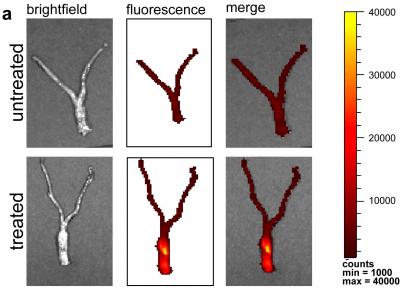Home > Press > Nanotechnology holds promise for STD drug delivery
 |
| Distribution of nanoparticles seen by fluorescence throughout mouse reproductive tract.
Credit: Woodrow/Yale |
Abstract:
Yale researchers describe a breakthrough in safe and effective administration of potential antiviral drugs — small interfering RNA (siRNA) molecules that silence genes — the first step in development of a new kind of treatment for sexually transmitted diseases (STDs). The work is reported May 4 as an advance online publication of Nature Materials.
Nanotechnology holds promise for STD drug delivery
New Haven, CT | Posted on May 3rd, 2009"RNA interference is a promising approach for prevention and treatment of human disease," said lead author Kim Woodrow, Yale postdoctoral fellow in Yale's School of Engineering & Applied Science. "We wanted to develop a new strategy of delivering siRNAs with a FDA-approved material."
As their name suggests, siRNAs interfere and knock out the function of genes in higher organism as well as in microbes that may cause STDs. The researchers designed siRNAs to target a gene expressed widely in the lining of the female mouse reproductive tract, in this proof-of-principle work.
Using densely-loaded nanoparticles made of a biodegradable polymer known as PLGA, the researchers created a stable "time release" vehicle for delivery of siRNAs to sensitive mucosal tissue like that of the female reproductive system.
They found that the particles, loaded with the drug agent, moved effectively in two important ways, penetrating to reach cells below the surface of the mucosa and distributing throughout the vaginal, cervical, and uterine regions. Furthermore, the siRNAs stayed in the tissues for at least a week and knockdown of gene activity lasted up to 14 days.
While past work has focused on delivery of siRNAs with liposomes, bubble-like carriers made of phospholipids similar to those found in cell membranes, liposomes are potentially more toxic to the mucosal tissues and are unable to provide sustained release. In the current work, the researchers demonstrated that PLGA nanoparticles were safer than the best current lipid vehicles.
Gene interference therapy is moving rapidly from basic research to application. The PLGA packaging these researchers chose is already approved as safe and non-toxic by the FDA, speeding the path to clinical trials for infectious agents such as HPV and HIV.
"Before human clinical testing can begin, our next step in research will be to test this approach directly in disease models - for example in the HIV model mice that have an immune system genetically identical to humans," said senior author W. Mark Saltzman, the Goizueta Foundation Professor of Biomedical Engineering & Chemical Engineering.
This approach holds promise for global health and the ability of people to self-apply antimicrobial treatments. Woodrow said, "It is safe and effective and much easier than getting an injection of vaccine."
Other authors from Yale are Yen Cu, Carmen J. Booth, Jennifer K. Saucier-Sawyer and Monica J.Wood. The research was funded by grants from the National Institutes of Health and fellowship support from the L'Oreal FWIS.
Citation: Nature Materials, advance online publication May 4, 2009.
####
For more information, please click here
Contacts:
Janet Rettig Emanuel
203-432-2157
Copyright © Yale University
If you have a comment, please Contact us.Issuers of news releases, not 7th Wave, Inc. or Nanotechnology Now, are solely responsible for the accuracy of the content.
| Related Links |
![]() School of Engineering & Applied Science
School of Engineering & Applied Science
| Related News Press |
News and information
![]() Researchers develop molecular qubits that communicate at telecom frequencies October 3rd, 2025
Researchers develop molecular qubits that communicate at telecom frequencies October 3rd, 2025
![]() Next-generation quantum communication October 3rd, 2025
Next-generation quantum communication October 3rd, 2025
![]() "Nanoreactor" cage uses visible light for catalytic and ultra-selective cross-cycloadditions October 3rd, 2025
"Nanoreactor" cage uses visible light for catalytic and ultra-selective cross-cycloadditions October 3rd, 2025
Nanomedicine
![]() New molecular technology targets tumors and simultaneously silences two ‘undruggable’ cancer genes August 8th, 2025
New molecular technology targets tumors and simultaneously silences two ‘undruggable’ cancer genes August 8th, 2025
![]() New imaging approach transforms study of bacterial biofilms August 8th, 2025
New imaging approach transforms study of bacterial biofilms August 8th, 2025
![]() Cambridge chemists discover simple way to build bigger molecules – one carbon at a time June 6th, 2025
Cambridge chemists discover simple way to build bigger molecules – one carbon at a time June 6th, 2025
![]() Electrifying results shed light on graphene foam as a potential material for lab grown cartilage June 6th, 2025
Electrifying results shed light on graphene foam as a potential material for lab grown cartilage June 6th, 2025
Discoveries
![]() Researchers develop molecular qubits that communicate at telecom frequencies October 3rd, 2025
Researchers develop molecular qubits that communicate at telecom frequencies October 3rd, 2025
![]() Next-generation quantum communication October 3rd, 2025
Next-generation quantum communication October 3rd, 2025
![]() "Nanoreactor" cage uses visible light for catalytic and ultra-selective cross-cycloadditions October 3rd, 2025
"Nanoreactor" cage uses visible light for catalytic and ultra-selective cross-cycloadditions October 3rd, 2025
Announcements
![]() Rice membrane extracts lithium from brines with greater speed, less waste October 3rd, 2025
Rice membrane extracts lithium from brines with greater speed, less waste October 3rd, 2025
![]() Researchers develop molecular qubits that communicate at telecom frequencies October 3rd, 2025
Researchers develop molecular qubits that communicate at telecom frequencies October 3rd, 2025
![]() Next-generation quantum communication October 3rd, 2025
Next-generation quantum communication October 3rd, 2025
![]() "Nanoreactor" cage uses visible light for catalytic and ultra-selective cross-cycloadditions October 3rd, 2025
"Nanoreactor" cage uses visible light for catalytic and ultra-selective cross-cycloadditions October 3rd, 2025
|
|
||
|
|
||
| The latest news from around the world, FREE | ||
|
|
||
|
|
||
| Premium Products | ||
|
|
||
|
Only the news you want to read!
Learn More |
||
|
|
||
|
Full-service, expert consulting
Learn More |
||
|
|
||








